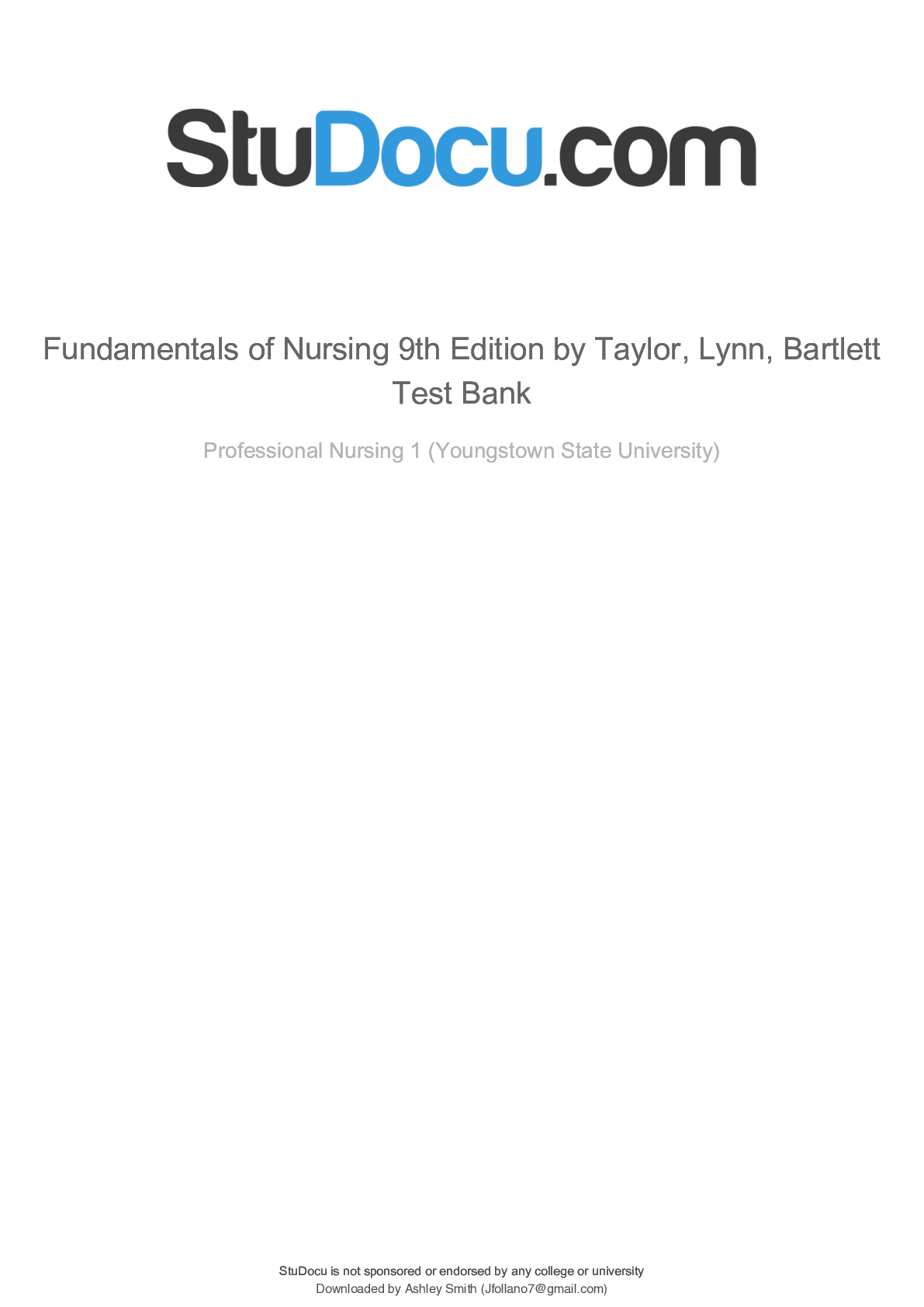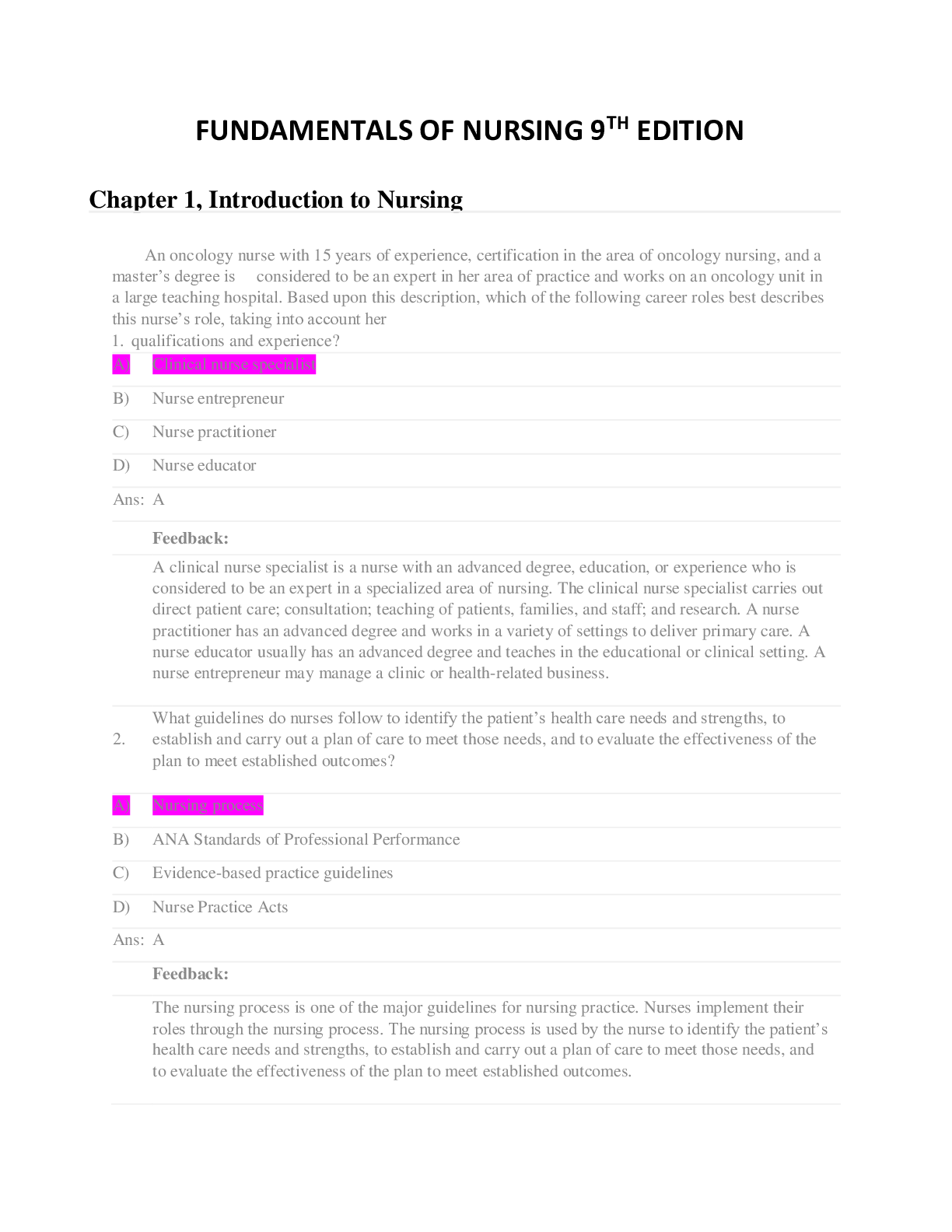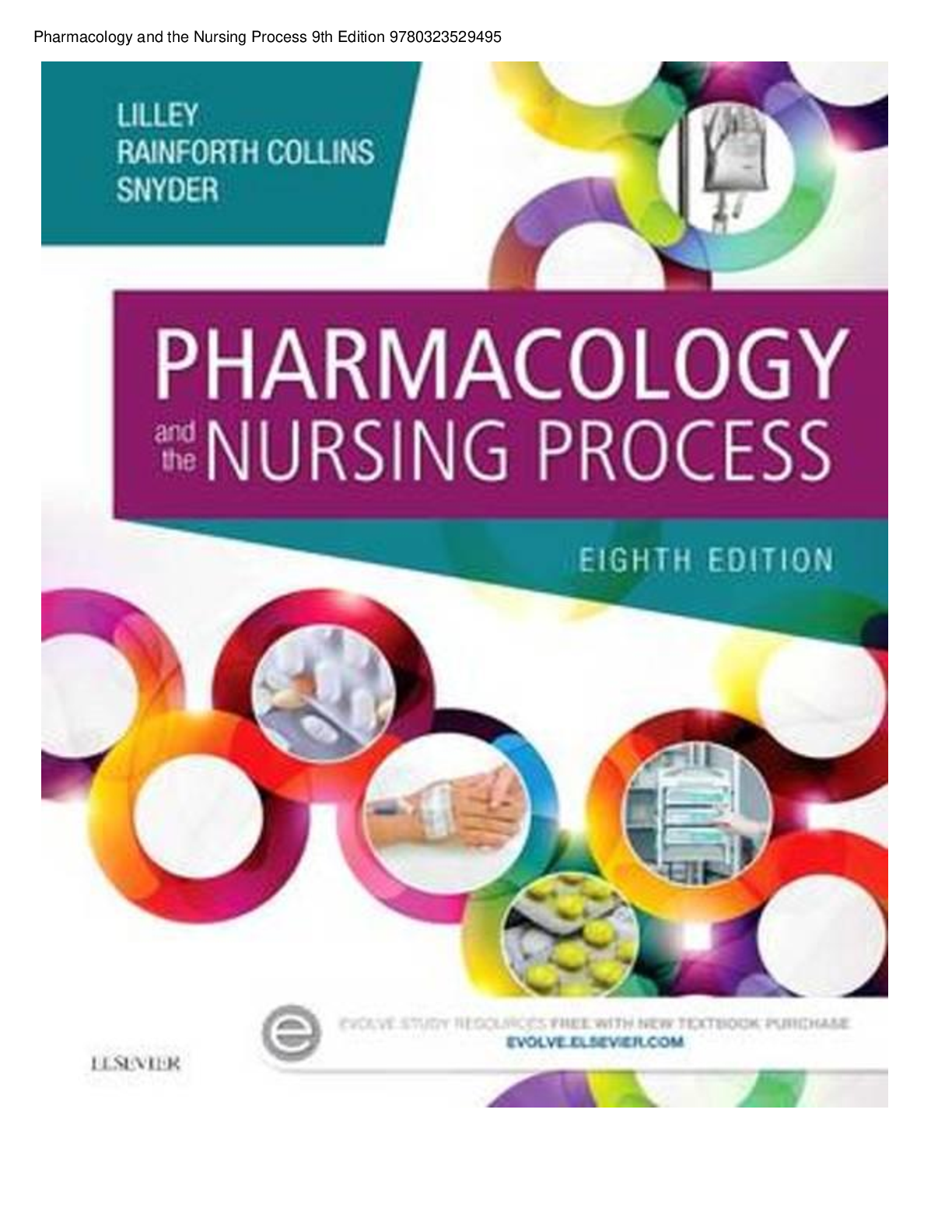Health Care > EXAM > fundamentals of nursing 9th edition potter perry test bank latest perry test bank latest (All)
fundamentals of nursing 9th edition potter perry test bank latest perry test bank latest
Document Content and Description Below
Fundamentals of Nursing 9th Edition Potter Perry Test Bank latest written by Realassistant www.stuvia.com Downloaded by: michaelren | mikecirino@ymail.com Distribution of this document is illega... l Downloaded by owni owni (owni168@iclous.com) lOMoARcPSD|9246639 NURSINGTB.COM Prime yourself for your Tests – Study Questions Chapter 41: Oxygenation Fundamentals of Nursing, 9th Edition MULTIPLE CHOICE 1. A nurse is teaching staff about the conduction of the heart. In which order will the nurse present the conduction cycle, starting with the first structure? 1. Bundle of His 2. Purkinje network 3. Intraatrial pathways 4. Sinoatrial (SA) node 5. Atrioventricular (AV) node a. 5, 4, 3, 2, 1 b. 4, 3, 5, 1, 2 c. 4, 5, 3, 1, 2 d. 5, 3, 4, 2, 1 ANS: B The conduction system originates with the SA node, the “pacemaker” of the heart. The electrical impulses are transmitted through the atria along intraatrial pathways to the AV node. It assists atrial emptying by delaying the impulse before transmitting it through the Bundle of His and the ventricular Purkinje network. 2. A nurse is teaching the patient with mitral valve problems about the valves in the heart. Starting on the right side of the heart, describe the sequence of the blood flow through these valves. 1. Mitral 2. Aortic 3. Tricuspid NURSINGTB.COM FUNDAMENTALS OF NURSING 9TH EDITION POTTER TEST BANK Stuvia.com - The Marketplace to Buy and Sell your Study Material Downloaded by: michaelren | mikecirino@ymail.com Distribution of this document is illegal Downloaded by owni owni (owni168@iclous.com) lOMoARcPSD|9246639 Stuvia.com - The Marketplace to Buy and Sell your Study Material NURSINGTB.COM Prime yourself for your Tests – Study Questions 4. Pulmonic a. 1, 3, 2, 4 b. 4, 3, 2, 1 c. 3, 4, 1, 2 d. 2, 4, 1, 3 ANS: C The blood flows through the valves in the following direction: tricuspid, pulmonic, mitral, and aortic. 3. A nurse explains the function of the alveoli to a patient with respiratory problems. Which information about the alveoli’s function will the nurse share with the patient? a. Carries out gas exchange b. Regulates tidal volume c. Produces hemoglobin d. Stores oxygen ANS: A The alveolus is a capillary membrane that allows gas exchange of oxygen and carbon dioxide during respiration. The alveoli do not store oxygen, regulate tidal volume, or produce hemoglobin. 4. A nurse auscultates heart sounds. When the nurse hears S2, which valves is the nurse hearing close? a. Aortic and mitral b. Mitral and tricuspid c. Aortic and pulmonic d. Mitral and pulmonic NURSINGTB.COM FUNDAMENTALS OF NURSING 9TH EDITION POTTER TEST BANK Downloaded by: michaelren | mikecirino@ymail.com Distribution of this document is illegal Downloaded by owni owni (owni168@iclous.com) lOMoARcPSD|9246639 Stuvia.com - The Marketplace to Buy and Sell your Study Material NURSINGTB.COM Prime yourself for your Tests – Study Questions ANS: C As the ventricles empty, the ventricular pressures decrease, allowing closure of the aortic and pulmonic valves, producing the second heart sound, S2. The mitral and tricuspid produce the first heart sound, S1. The aortic and mitral do not close at the same time. The mitral and pulmonic do not close at the same time. 5. The nurse is teaching about the process of exchanging gases through the alveolar capillary membrane. Which term will the nurse use to describe this process? a. Ventilation b. Surfactant c. Perfusion d. Diffusion ANS: D Diffusion is the process of gases exchanging across the alveoli and capillaries of body tissues.Ventilation is the process of moving gases into and out of the lungs. Surfactant is a chemical produced in the lungs to maintain the surface tension of the alveoli and keep them from collapsing. Perfusion is the ability of the cardiovascular system to carry oxygenated blood to tissues and return deoxygenated blood to the heart. 6. A nurse is caring for a patient who was in a motor vehicle accident that resulted in cervical trauma to C4. Which assessment is the priority? a. Pulse b. Respirations c. Temperature d. Blood pressure ANS: B Respirations and oxygen saturation are the priorities. Cervical trauma at C3 to C5 usually results in paralysis of the phrenic nerve. When the phrenic nerve is damaged, the diaphragm does not descend properly, thus reducing inspiratory lung volumes and causing hypoxemia. While pulse NURSINGTB.COM FUNDAMENTALS OF NURSING 9TH EDITION POTTER TEST BANK Downloaded by: michaelren | mikecirino@ymail.com Distribution of this document is illegal Downloaded by owni owni (owni168@iclous.com) lOMoARcPSD|9246639 Stuvia.com - The Marketplace to Buy and Sell your Study Material NURSINGTB.COM Prime yourself for your Tests – Study Questions and blood pressure are important, respirations are the priority. Temperature is not a high priority in this situation. 7. The patient is breathing normally. Which process does the nurse consider is working properly when the patient inspires? a. Stimulation of chemical receptors in the aorta b. Reduction of arterial oxygen saturation levels c. Requirement of elastic recoil lung properties d. Enhancement of accessory muscle usage ANS: A Inspiration is an active process, stimulated by chemical receptors in the aorta. Reduced arterial oxygen saturation levels indicate hypoxemia, an abnormal finding. Expiration is a passive process that depends on the elastic recoil properties of the lungs, requiring little or no muscle work. Prolonged use of the accessory muscles does not promote effective ventilation and causes fatigue. 8. The home health nurse recommends that a patient with respiratory problems install a carbon monoxide detector in the home. What is the rationale for the nurse’s action? a. Carbon monoxide detectors are required by law in the home. b. Carbon monoxide tightly binds to hemoglobin, causing hypoxia. c. Carbon monoxide signals the cerebral cortex to cease ventilations. d. Carbon monoxide combines with oxygen in the body and produces a deadly toxin. ANS: B Carbon monoxide binds tightly to hemoglobin; therefore, oxygen is not able to bind to hemoglobin and be transported to tissues, causing hypoxia. A carbon monoxide detector is not required by law, does not signal the cerebral cortex to cease ventilations, and does not combine with oxygen but with hemoglobin to produce a toxin. NURSINGTB.COM FUNDAMENTALS OF NURSING 9TH EDITION POTTER TEST BANK Downloaded by: michaelren | mikecirino@ymail.com Distribution of this document is illegal Downloaded by owni owni (owni168@iclous.com) lOMoARcPSD|9246639 Stuvia.com - The Marketplace to Buy and Sell your Study Material NURSINGTB.COM Prime yourself for your Tests – Study Questions 9. While performing an assessment, the nurse hears crackles in the patient’s lung fields. The nurse also learns that the patient is sleeping on three pillows to help with the difficulty breathing during the night. Which condition will the nurse most likely observe written in the patient’s medical record? a. Atrial fibrillation b. Myocardial ischemia c. Left-sided heart failure d. Right-sided heart failure ANS: C Left-sided heart failure results in pulmonary congestion, the signs and symptoms of which include shortness of breath, cough, crackles, and paroxysmal nocturnal dyspnea (difficulty breathing when lying flat). Right-sided heart failure is systemic and results in peripheral edema, weight gain, and distended neck veins. Atrial fibrillation is often described as an irregularly irregular rhythm; rhythm is irregular because of the multiple pacemaker sites. Myocardial ischemia results when the supply of blood to the myocardium from the coronary arteries is insufficient to meet myocardial oxygen demands, producing angina or myocardial infarction. 10. A patient has a myocardial infarction. On which primary blood vessel will the nurse focus care to reduce ischemia? a. Superior vena cava b. Pulmonary artery c. Coronary artery d. Carotid artery ANS: C A myocardial infarction is the lack of blood flow due to obstruction to the coronary artery, which supplies the heart with blood. The superior vena cava returns blood back to the heart. The pulmonary artery supplies deoxygenated blood to the lungs. The carotid artery supplies blood to the brain. NURSINGTB.COM FUNDAMENTALS OF NURSING 9TH EDITION POTTER TEST BANK Downloaded by: michaelren | [Show More]
Last updated: 2 years ago
Preview 1 out of 775 pages

Buy this document to get the full access instantly
Instant Download Access after purchase
Buy NowInstant download
We Accept:

Reviews( 0 )
$13.00
Can't find what you want? Try our AI powered Search
Document information
Connected school, study & course
About the document
Uploaded On
Aug 13, 2022
Number of pages
775
Written in
Additional information
This document has been written for:
Uploaded
Aug 13, 2022
Downloads
0
Views
117

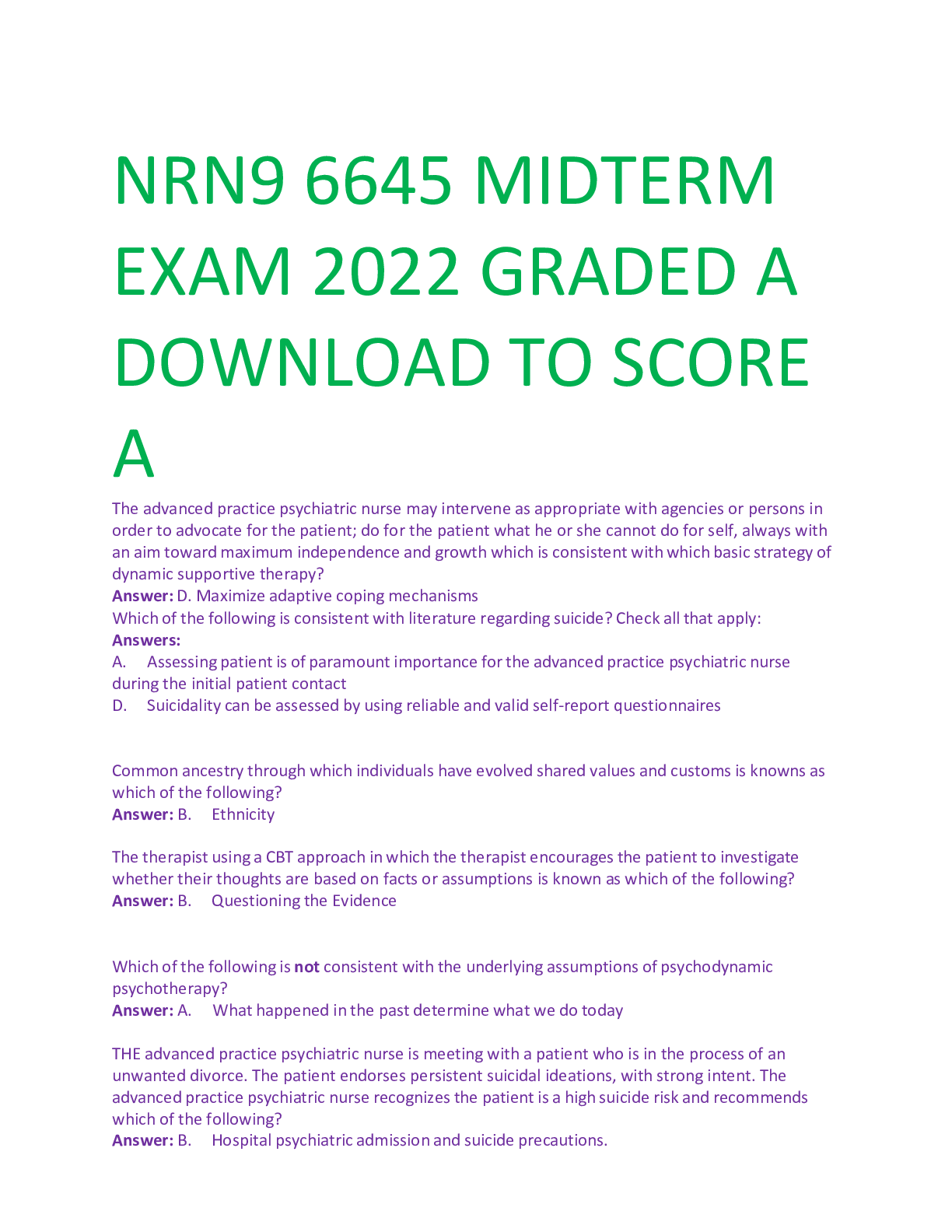


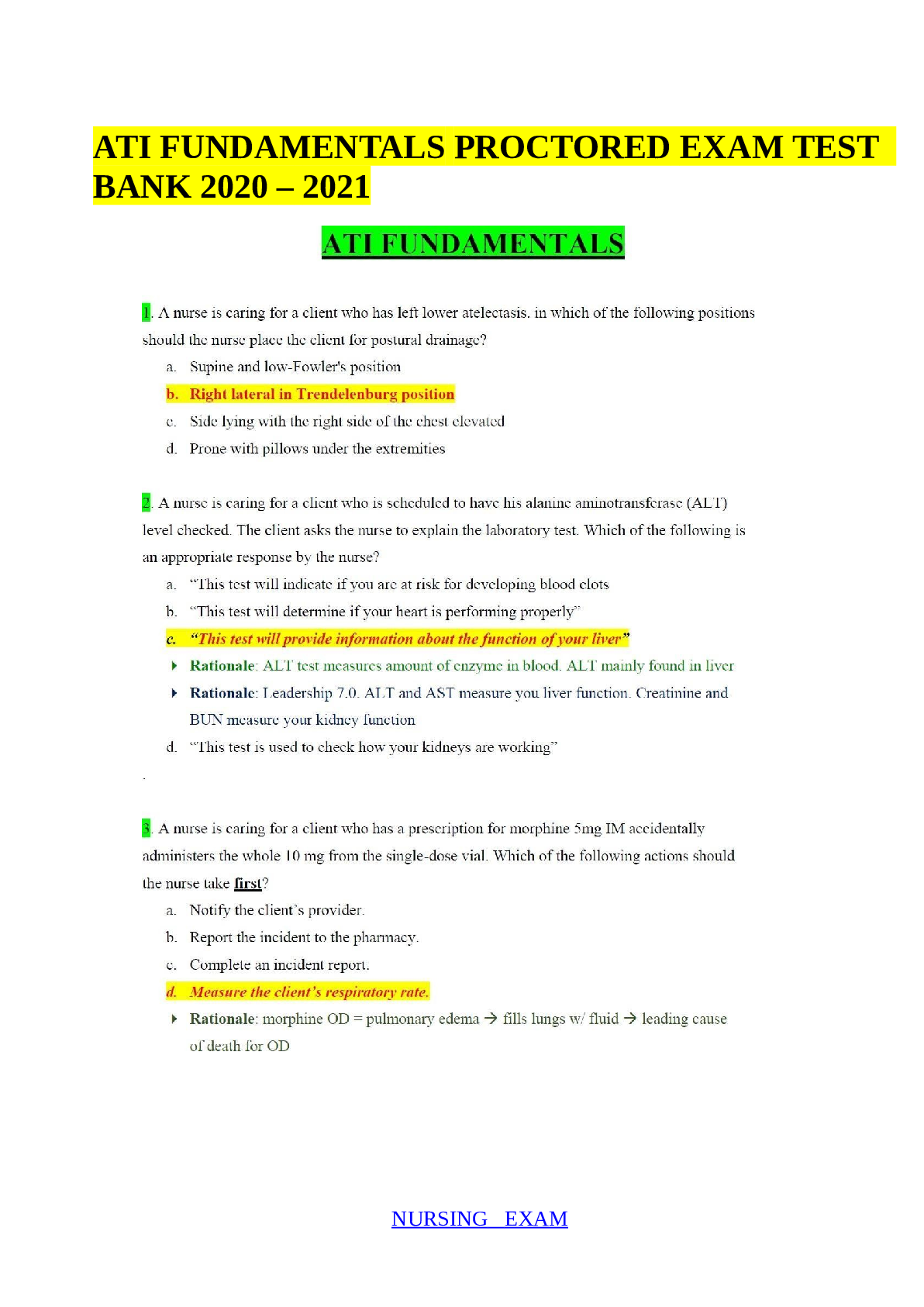
.png)
.png)

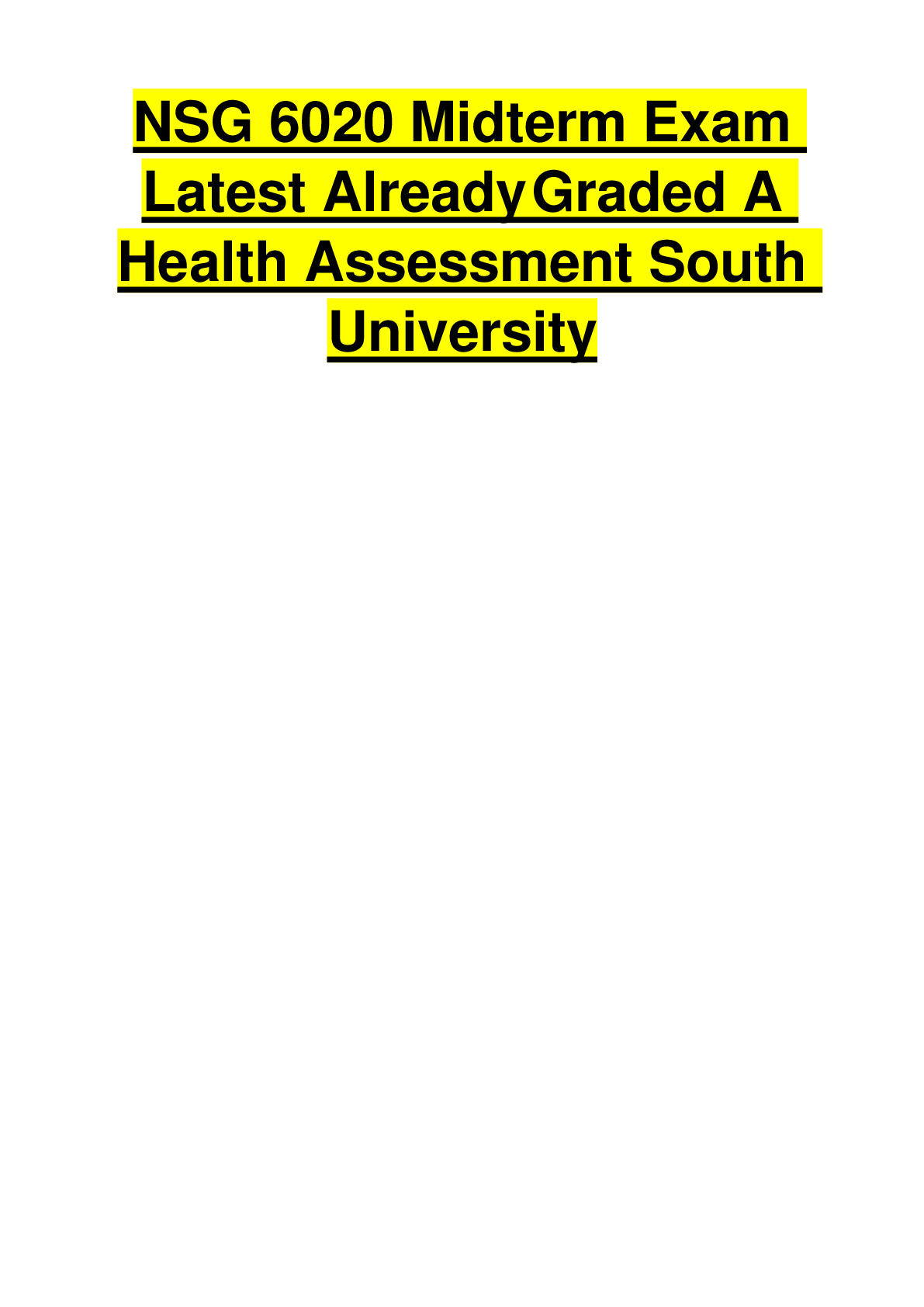






.png)

